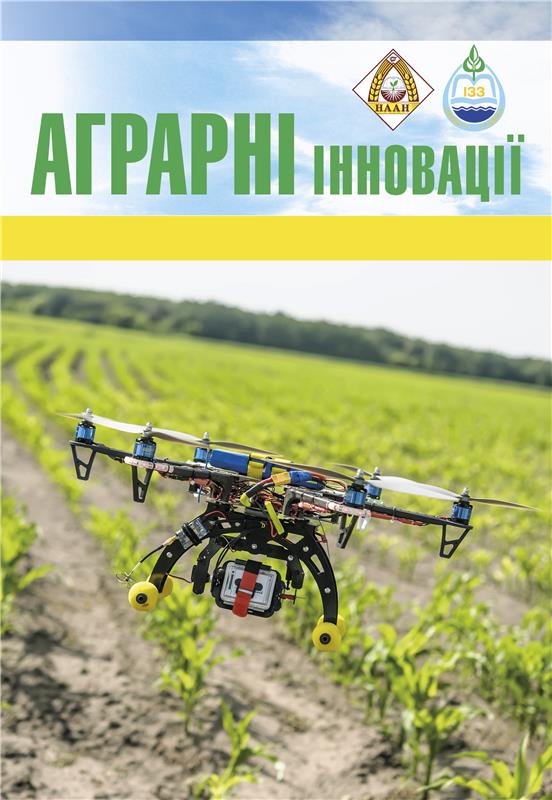AGRONOMIC ASPECTS OF FORMING YIELD STRUCTURE ELEMENTS IN SPRING PEAS UNDER THE CONDITIONS OF RIGHT-BANK FOREST STEPPE IN UKRAINE
Abstract
Although all leguminous crops are necessary for crop rotation, there is one crop that Ukrainian farmers currently prefer the most (after soybeans, of course) – peas, a high-protein crop. There is now a wide range of domestic and foreign pea varieties that are better adapted to environmental conditions and more productive than those sown 10–15 years ago. These varieties are more resistant to flower shedding, better seed retention, lodging, weed suppression, and significant damage from pests and diseases. Modern cultivation technologies are adapted to "new varieties," unlike previous years. Analyzing the crop structure is an essential method for evaluating crop development. The key elements of pea yield structure include the number of preserved flowers and pods on the plant, the number of seeds per pod, and the weight of 1000 seeds.The main purpose. The research aimed to study the effects of inoculants, mycorrhizal-forming agents, and micronutrients on the formation of the individual productivity of field peas in the Right-Bank Forest Steppe of Western Ukraine.Research methods and materials. Experimental studies were conducted from 2020 to 2024 at the Podillia Research and Development Center of Podillia State University. The experiment studied the pea varieties HAMBIT and ESO.The results. It was proven that biological preparations studied, such as MIKOFREND, NITROFIKS, RYZOAKTYV, NAIS, and AVANHARD, significantly impacted flowerformation and retention. Applying only mycorrhizal-forming agents and inoculants led to more significant abortion of flowers on plants and poorer pod formation. Positive effects were observed in experimental plots where a combination of MIKOFREND and RYZOAKTYV Legumes inoculant was applied. Many flowers fell off in the absolute control plots, ranging from 65,4% to 66,1%. With the use of inoculants, mycorrhizal-forming agents, and micronutrients, flower retention was 80,6–88,4%. The number of preserved pods per plant was 5,8–14,5 pcs/plant. The 1000-seed weight for the HAMBIT pea variety ranged from 232.3 to 248.9 grams, and for the ESO variety, it ranged from 222.5 to 239.5 grams.Findings. The most favourable conditions for the growth, development, and formation of yield structure elements in field peas were achieved by applying pre-sowing biological preparations and foliar feeding with biofertilizers.
References
2. Ткачук О.П., Врадій О.І. Баланс поживних речовин у ґрунті при вирощуванні зернобобових культур. Екологічні науки. 2022. № 2(41). С. 43–47. DOI https:// doi.org/10.32846/2306-9716/2022.eco.2-41.7
3. Мазур В.А. Науково-теоретичне обґрунтування технологічних прийомів вирощування гороху овочевого в умовах Лісостепу правобережного : монографія / Дідур І.М., Мостовенко В.В., Мазур О.В. Вінниця, 2022. 224 с.
4. Khomina V., Lapchynskyi V., Pustova Z., Nebaba K., Plahtiy D. Microbial inoculants as a means of improving soil and crop yields. Scientific Horizons. 2024. Vol. 27. № 10. Рр. 79–90. https://doi.org/10.48077/ scihor10.2024.79
5. Гамаюнова В.В., Єрмолаєв В.М. Урожайність зерна гороху залежно від передпосівної обробки насіння та оптимізації живлення в умовах Південного Степу України. Аграрні інновації. 2024. № 23. С. 228–233. https://doi.org/10.32848/agrar.innov.2024.23.33
6. Центило Л.В. Функціонування азотфіксувального симбіозу та продуктивність гороху за різних видів і рівнів удобрення. Сільськогосподарська мікробіологія. 2016. № 24. С. 37–42. https://doi. org/10.35868/1997-3004.24.37-42
7. Tulbek M.C., LamY., Wang P., Asavajaru A. Pea: A Sustainable Vegetable Protein Crop. Sustainable Protein Sources. 2017. Р. 145–164. https://doi. org/10.1016/B978-0-12-802778-3.00009-3
8. Кобак С., Колісник С., Сереветник О., Чорна В. Абортивність у сої: причини та шляхи вирішення проблеми. Пропозиція. 2017. № 6. С. 90–94. https:// surl.li/ijqqba
9. Чинчик О. С. Вплив обробки насіння біопрепаратами на показники структури урожаю та урожайність сортів гороху. Збірник наукових праць ПДАТУ. 2016. № 24, ч. 1. С. 222–229.
10. Nebaba K., Khmelianchyshyn Yu., Panasiuk R., Puczel J., Koberniuk O. Influence of biostimulants on physiological processes, productivity, and quality of pea crop in modern agriculture. Scientific Horizons. 2025. Vol. 28. № 1. Pp. 61–72. https://doi.org/10.48077/ scihor1.2025.61
11. Небаба К.С., Хмелянчишин Ю.В. Формування індивідуальної та насіннєвої продуктивності гороху посівного залежно від агротехнічних прийомів вирощування в умовах лісостепу західного. Подільський вісник: сільське господарство, техніка, економіка. 2023. №. 40. С. 34–39. https://doi.






